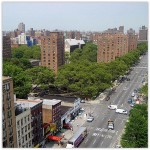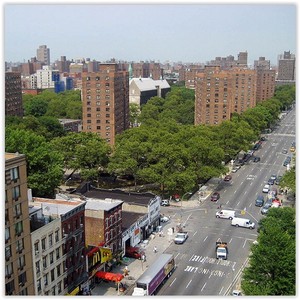 East Harlem, also known as Spanish Harlem and El Barrio, is a neighborhood of Upper Manhattan, New York Cityroughly encompassing the area north of 96th Street and east of Fifth Avenue to the East and Harlem Rivers. It lies within Manhattan Community District 11. Despite its name, it is sometimes not considered to be a part of Harlem.
East Harlem, also known as Spanish Harlem and El Barrio, is a neighborhood of Upper Manhattan, New York Cityroughly encompassing the area north of 96th Street and east of Fifth Avenue to the East and Harlem Rivers. It lies within Manhattan Community District 11. Despite its name, it is sometimes not considered to be a part of Harlem.
The neighborhood is one of the largest predominantly Latino communities in New York City, mostly made up of Puerto Ricans, as well as a rising number of Dominican, Salvadoran and Mexican immigrants. It includes the area formerly known as Italian Harlem, in which the remnants of a once predominantly Italian community remain. The Chinesepopulation has increased dramatically in East Harlem since 2000.
East Harlem suffers from many social issues, such as the highest jobless rate in New York City, teenage pregnancy, AIDS,drug abuse, homelessness, and an asthma rate five times the national average. It has the second highest concentration of public housing in the United States, closely following Brownsville, Brooklyn. The area has the highest violent crime rate in Manhattan. Police services to the neighborhood are divided between the 23rd and the 25th Precincts.
East Harlem is notable for its contributions to Salsa music and Hip-Hop.
HISTORY
Early History
The area which became East Harlem was rural for most of the 19th century, but residential settlements northeast of Third Avenue and East 110th Street had developed by the 1860s. The construction of the elevated transit line to Harlem in 1879 and 1880, and the building of the Lexington Avenue subway in 1919, urbanized the area, precipitating the construction of apartment buildings and brownstones. The extension of cable cars up Lexington Avenue into East Harlem was stymied by the incline created by Duffy’s Hill at103rd Street, one of the steepest grades in Manhattan. East Harlem was first populated by poor German, Irish, Scandinavian and Eastern European Jewish immigrants, with the Jewish population standing at 90,000 around 1917. In the 1870s, Italian immigrants joined the mix after a contractor building trolley tracks on First Avenue imported Italian laborers as strikebreakers. The workers’ shantytown along the East River at 106th Street was the beginning of an Italian neighborhood, with 4,000 having arrived by the mid 1880s. As more immigrants arrived, it expanded north to East 115th Street and west to Third Avenue.
East Harlem now consisted of pockets of ethnically-sorted settlements – Italian, German, Irish and Jewish – which were beginning to press up against each other, with the spaces still between them occupied by “gasworks, stockyards and tar and garbage dumps”. In 1895, Union Settlement Association, one of the oldest settlement houses in New York City, began providing services in the area, offering the immigrant and low-income residents a range of community-based programs, including boys and girls clubs, a sewing school and adult education classes.
Italian Harlem
Southern Italians and Sicilians, with a moderate number of Northern Italians, soon predominated, especially in the area east of Lexington Avenue between 96th and 116th Streets and east of Madison Avenue between 116th and125th Streets, with each street featuring people from different regions of Italy. The neighborhood became known as “Italian Harlem”, the Italian American hub of Manhattan; it was the first part of Manhattan to be referred to as “Little Italy”. The first Italians arrived in East Harlem in 1878, from Polla in the province of Salerno, and settled in the vicinity of 115th Street.
There were many crime syndicates in Italian Harlem from the early Black Hand to the bigger and more organized Italian gangs that formed the Italian-American Mafia. It was the founding location of the Genovese crime family, one of the Five Families that dominated organized crime in New York City. This includes the current 116th Street Crew of the Genovese family. During the 1970s, Italian East Harlem was also home to the Italian-American drug gang and murder-for-hire crew know as the East Harlem Purple Gang.
In the 1920s and early 1930s, Italian Harlem was represented in Congress by future Mayor Fiorello La Guardia, and later by Italian-American socialist Vito Marcantonio. The Italian neighborhood approached its peak in the 1930s, with over 100,000 Italian-Americans living in its crowded, run-down apartment buildings. The 1930 census showed that 81 percent of the population of Italian Harlem consisted of first- or second-generation Italian Americans. (Somewhat less than the concentration of Italian Americans in the Lower East Side’s Little Italy with 88 percent; Italian Harlem’s total population, however, was three times that of Little Italy.)
Though small, Italian Harlem culture is still kept alive by the Giglio Society of East Harlem. Every year on the second weekend of August, the Feast of Our Lady of Mount Carmel and the “Dancing of the Giglio” is performed while thousands of visitors and onlookers celebrate the once largest Italian community in New York City. Pleasant Avenue remains the center of the remaining Italian-American population, and the street is home to the famous Italian restaurant Rao’s.
Spanish Harlem
Puerto Rican and Latin American immigration after the First World War established an enclave at the western portion of East Harlem – around 110th Street and Lexington Avenue – which became known as “Spanish Harlem”. The area slowly grew to encompass all of East Harlem, including Italian Harlem, as Italians moved out – to the Bronx,Brooklyn, upstate New York and New Jersey – and Hispanics moved in during another wave of immigration in the 1940s and 1950s. Although in certain areas, particularly around Pleasant Avenue, Italian Harlem lasted through the 1970s, today most of the former Italian population is gone. Most of these predominantly older residents are clustered around Our Lady of Mount Carmel Church, mainly from 114th to 118th Streets. According to the 2000 Census, there were only 1,130 Italian-Americans still living in this area.
Still, vestiges of the old Italian neighborhood remain. The annual Feast of Our Lady of Mount Carmel and the “Dancing of the Giglio”, the first Italian feast in New York City, is still celebrated there every year on the second weekend of August by the Giglio Society of East Harlem. Italian retail establishments still exist, such as Rao’s restaurant, started in 1896, and the original Patsy’s Pizzeria which opened in the 1933. In May 2011, one of the last remaining Italian retail businesses in the neighborhood, a barbershop owned by Claudio Caponigro on 116th Street, was threatened with closure by a rent increase.
The newly dominant Puerto Rican population, which reached 63,000 in 1950, continued to define the neighborhood according to its needs, establishing bodegas and botánicas as it expanded; by the 1930s there was already an enclosed street market underneath the Park Avenue railroad viaduct between 111th and 116th Streets, called “La Marqueta” (“The Market”). Catholic and evangelistic Protestant churches appeared in storefronts. Although “Spanish Harlem” had been in use since at least the 1930s to describe the Hispanic enclave – along with “Italian Harlem” and “Negro Harlem” – around the 1950s the name began to be used to describe the entire East Harlem neighborhood. Later, the name “El Barrio” (“The Neighborhood”) began to be used, especially by inhabitants of the area.
Decline
In the 1950s and 1960s, large sections of East Harlem were leveled for urban renewal projects, and the neighborhood was one of the hardest hit areas in the 1960s and 1970s as New York City struggled with deficits, race riots, urban flight, gang warfare, drug abuse, crime and poverty. Tenements were crowded, poorly maintained, and frequent targets for arson. In 1969 and 1970, a regional chapter of the Young Lords which were reorganized from a neighborhood street gang in Chicago by Jose (Cha-Cha) Jimenez, ran several programs including a Free Breakfast for Children and a Free Health Clinic to help Latino and poor families. The Young Lords came together with the Black Panthers and called forPuerto Rican self-determination and neighborhood empowerment. In the 21st century the Latin Kings gang is prevalent in East Harlem.
Recent History
By the beginning of the 21st century, East Harlem was a racially diverse neighborhood, with about a third of the population being Puerto Rican. As it has been throughout its history, it is predominantly a working-class neighborhood.
Until 2006, property values in East Harlem climbed along with those in the rest of New York City. With increased market rate housing, including luxury condos and co-ops, most built on formerly vacant lots, there has been some decline of affordable housing in the community. A number of young professionals have settled into these recently constructed buildings. This influx of “yuppies” has caused rents to rise, more buildings in the area to get gut renovations and is changing area demographics.
On March 12, 2014 at 9:00 EDT, a large explosion and fire at 1644–1646 Park Avenue killed at least eight people and injured more than 70.
DEMOGRAPHICS
Manhattan Community District 11, which covers East Harlem in its entirety, is a mostly low and moderate income area. It is made up of first and second generation Puerto Ricans, African-Americans, Asians, West Indians, and a growing population of Mexicans, Dominicans, Salvadorans, and other Central American immigrants.
It has one of the highest concentrations of Puerto Ricans in all of New York City. In the 2000 Census, 52.1% District describe themselves as of Hispanic origin, 35.7 as non-Hispanic black, 7.3 as non-Hispanic white, 2.7 Asian and Pacific Islander Nonhispanic, 1.7% as Two or more Races non-Hispanic, and 0.5% as other. By New York City averages, the youth makes up a larger than normal percentage of the East Harlem population with 30.6% of residents age 18 or younger.
93.6% of all housing units are renter occupied, and over 25% of the population resides in public housing units managed by theNYCHA. 46.5 percent of the population receive a form of income support by the government.
According to a 2010 study, the number of Asians in East Harlem nearly tripled between 2000 and 2010, largely due to Chinese people moving to East Harlem. Increasing rents in Lower Manhattan’s Chinatown have driven many into public and subsidized housing developments in the neighborhood. Advocates have been calling for Chinese language services to be available in the community centers to accommodate the growing number of Chinese residents in the area. In 2000, the Chinese population in the northern portion was less than one percent, but by 2010, it has gone up to being three percent in the area. In the southern part, it rose from 4.6% to 8.4%.
As of 2010, the Puerto Rican population was 27.7% in zip code 10029, and 23.4% in 10035. 10035 also has a large Mexican population, at 10.7%.

